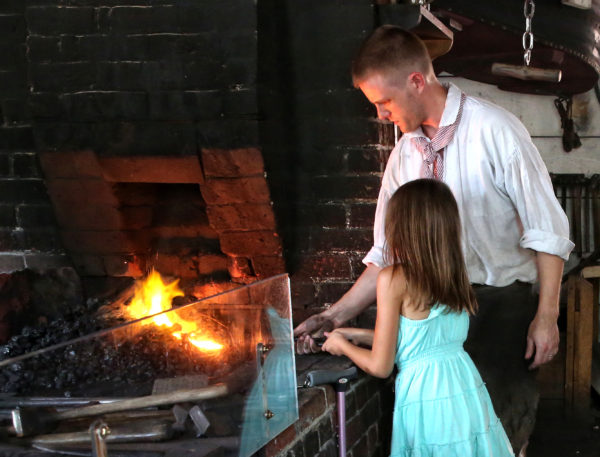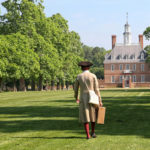
Has your child expressed an interest in learning a trade? A brand new program geared toward kids lets them work in three different trades shops to get some real hands-on experience. Let’s talk about The Apprentice.
When I was a kid, I had a lot of grand ideas about what I wanted to be when I grew up. From astronaut to prosector and most definitely the first female president of the United States of America, my interests have varied. This has stayed with me my entire life. While my love of politics and history trumps most everything else, I’m also a French film fanatic with a penchant for murder mysteries and trying to figure out how to make tofu taste like bacon (it’s doable and delicious, try it!). I’m a farmer out a Great Hopes Plantation who sometimes splits wood and helps the Carpenters with projects because I love getting my hands dirty and learning new things every day. It’s one of the many things I love about working for a place like Colonial Williamsburg. It’s my job to do just that.
If your child is anything like me, this is the perfect program for him or her. It’s recommended for kids ages 8 to 14 and each kid must be accompanied by a ticketed adult, meaning an adult must also purchase a ticket and escort the young apprentice. The young apprentices will be able to visit three trade shops during their time, which rotate based on specific days of the week.
On Mondays through July 18, young apprentices will visit the Weavers, Wheelwrights, and Foundry. On Wednesdays through July 20, young apprentices will visit with the Coopers, Blacksmiths, and Milliners. On Saturdays through July 23, young apprentices will visit with the Tinsmiths, Cabinetmakers, and Brickyard.
On Mondays beginning July 25, young apprentices will visit with the Wigmakers, Cabinetmakers, and Brickyard. On Wednesdays beginning July 27, young apprentices will visit with the Coopers, Milliners, and Silversmiths. On Saturdays beginning July 30, young apprentices will visit with the Weavers, Shoemakers, and Printing Office.
So there are lots of chances to visit with several shops! Planning to be here for a week? Take advantage of more than one day and discover a whole new experience. The days, times, and shops are always subject to change. I recommend checking when you purchase your tickets.
Once you’ve signed up, the young apprentices will meet with a group leader at the Lumber House Ticket Office. The group leader will escort the group to the first shop while giving a little history about apprenticeships and trades. You’ll spend about 20 minutes at each of the three shops learning about the trade and getting a true, VIP experience, because the shops will be closed to the public during that time. Each shop has a takeaway in the form of a handout, which explains the history of the trade and some other fun information, as well as an object representing that trade.
Here’s some information on what the young apprentices will get to do at the shops they visit.
At the Anderson Armoury, young apprentices will be able to participate in a small forging project. They’ll help fan the fire with the bellows and heat an S-Hook to add a decorative twist. Each young apprentice will get to take his or her finished S-Hook home. I was able to do just that with Aislinn. After we got the fire going, I slid the hook into the hot coals and used the bellows to fan the fire. I was able to twist the hook twice around and swished it in the water to cool! My hook is now one of my treasured possessions.
Treading clay at the Brickyard is a treat for everyone, but the young apprentices participating in the program will also be allowed to mold small bricks and set them out to dry. The brickmakers will explain some of the history behind brickmaking and how children sometimes worked in brickyards in the 18th century. At the end of their time, they’ll get to take home some clay marbles.
Over at the Cabinetmaker Shop, young apprentices will learn the fundamental techniques of cabinetmaking. They’ll then have the chance to plane and saw as well as work with traditional hide glue to do a little veneering.
Young apprentices visiting with the Coopers will have a chance to use two different types of drawknives—a backing knife and a hollowing knife—to see how the curvatures are cut into the staves that make up the walls of barrels and buckets. Assembling a bucket and rolling a barrel are two additional activities.
The Milliners will talk about the trade and things milliners would import and sell. They’ll highlight artificial flowers that were imported mostly from France and Italy and made from paper and linen. Young apprentices will then make an artificial flower.
At the Print Shop, our young apprentices will have a lesson at the type cases and learn how to use the letter press. They’ll be able to keep what they print!
At the Tin Shop, young apprentices will punch tin to create a decorative pattern using a hammer and punches. They’ll get to take home their piece of tin!
Over at the Foundry, the young apprentices will be introduced to the trade and learn the techniques and experiences an apprentice of the 18th century would.
The Shoemakers show young apprentices how to measure their feet with a paper tape. The young apprentices will receive samples of the various types of leather used in shoemaking as well as heel pegs and a Didsbury order form.
Some activities with the Silversmiths include drawing an outline of a trade silver template on a handout and helping draw silver wire on the drawbench. Young apprentices are permitted to have a piece of finely drawn silver wire sealed to the handout, which includes some games they can play.
Young apprentices working with the Weavers will be able to pick seeds from cotton (one of my favorite things to do at Great Hopes Plantation), card wool and/or cotton, make some yarn on the spinning wheel, weave on a small loom, and wind a bobbin they get to keep.
On a visit to the Wheelwrights, young apprentices will learn about mortise and tenon joinery, wheels, wheelbarrow frames, carts, and wagons. After a chat about how to make a dowel, the apprentices will drive a prepared dowel blank through a dowel plate, making the dowel themselves.
At the Wig Shop, the young apprentices will work in three stations: washing wigs; combing out wigs and hairpieces; and looms for weaving hair. The Wigmakers then demonstrate how the wigs would have been worn and teach courtesies. It turns into a little competition between the boys and the girls! Each young apprentice takes home a bar of soap.
Tickets are $15 for everyone and can be purchased online or at any ticket location. Make sure to share pictures of your young apprentices with us, we’d love to see them! If you were able to be an apprentice for a day, which shops would you like to visit?
And a huge thank you to Making History friend Fred Blystone for the incredible pictures! He’s been working with all of our Trades on this and so many other programs.

Nancy Huber says
Awesome. Can you keep the program going in the fall and at Christmas ?
I’ll let them know, Nancy!
B. Fingerhut says
I’d like it very much if adults, too, could do work in the shops like the apprentice program for children, as shown.. A year ago, my spouse and I helped for 3 days raise the Market House and Scale House. We are woodworkers and beginning timber-framers…. Isn’t there a way for adults to take a crafts part in CWF? Please let us know.
I recommend just asking as you visit the trade shop and seeing if there’s any hands-on things you could do! Sometimes trades will take volunteers, so talk with the shops and see if anyone has any spots for a volunteer!
Geoff H says
Don’t forget to check out Less Talking, More Doing! You’ll get to make (and keep!) a belt at the Artificer’s shop.
https://www.colonialwilliamsburg.com/plan/calendar/less-talking-more-doing/?eventId=15751&startTime=07-12-2016+9:00:00.0
What a wonderful program. Hopefulky it will plant the seeds for future Williamsburg trade people.
Agreed, Gail!